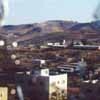The first Americans killed in Gaza?
23 October 2003
A reader of the Independent of London complains that a headline contained misinformation. Read more about The first Americans killed in Gaza?
23 October 2003
A reader of the Independent of London complains that a headline contained misinformation. Read more about The first Americans killed in Gaza?

21 October 2003
The international media seminar on the question of peace in the Middle East, now taking place in Seville, Spain, reaffirmed the utility of dialogue and mutual understanding. The participants heard four speakers in the morning session and four speakers in the afternoon session of the two-day meeting. In his opening remarks, the moderator, Shashi Tharoor, Under-Secretary-General for Communications and Public Information, expressed his hope that the seminar would be an occasion for dialogue and conciliation rather than condemnation and criticism. Read more about Media coverage of Middle East situation among issues discussed at seminar on conflict in region

14 October 2003
The question of peace in the Middle East will be the subject of an international media seminar organized by the Department of Public Information (DPI) on 21 and 22 October in Seville, Spain. Co-hosted by the Three Cultures of the Mediterranean Foundation, the two-day meeting will bring together present and former policy-makers from Israel and the Palestinian Authority, as well as senior United Nations officials, international experts and representatives of the world media. Read more about UN to host media seminar on peace in Middle East
26 March 2002
Various news organisations reporting on the killing of one Turkish and one Swiss member of the Temporary International Presence in Hebron (TIPH) have included the Israeli claim that it was Palestinian gunmen who opened fire on the TIPH vehicle. A TIPH spokesperson, reached by telephone in Hebron by The Electronic Intifada today categorically stated that TIPH had “No information on the shooting.” Read more about Advisory: TIPH reports "no information on the shooting" of two of its personnel

17 September 2003
Mother Jones demonstrated how low it could set its standards for investigative journalism when it hired Newsweek reporter Joshua Hammer to surf the web and write a 7000-word feature story on Rachel Corrie and the International Solidarity Movement (“The Death of Rachel Corrie”, Sept/Oct 2003). Indeed fact-checking and verification was not a priority in the production of this article. Phan Nguyen reports. Read more about Speculative Journalism: The making of "The Death of Rachel Corrie"

14 September 2003
A Partners for Peace letter was published in the New York Times Magazine of September 14, 2003. The letter appeared after weeks of effort to have the Magazine acknowledge that the illegal settlement of Har Homa (Jabal Abu Ghneim) is not part of Israel. Michael Brown reports. Read more about Persistent Partners for Peace squeezes a correction out of the New York Times Magazine

22 August 2003
The deadly bus bombing in Jerusalem on August 19 was foreshadowed by a pair of suicide attacks a week earlier which killed two Israeli civilians. While U.S. media tended to portray these attacks as a return to violence after a relatively peaceful period, there were numerous killings in the weeks leading up to the suicide bombings that underscore the lack of evenhanded attention given to loss of life in the Israeli/Palestinian conflict. FAIR reports. Read more about Journalists find "calm" when only Palestinians die

27 August 2003
During my formative years in North Carolina, my daddy used to say to me, “Son, you can lead a horse to water, but you can’t make it drink.” My father’s adage applies all too well to CNN. Over the past 16 months, Partners for Peace has repeatedly contacted CNN to explain that Shebaa Farms is not in Israel, but in occupied territory. Time and again, we have sent letters stating that the United Nations regards Shebaa Farms as Syrian while Hezbollah sees it as Lebanese. The one thing we know is that it is not Israeli. Michael Brown writes for EI. Read more about Shebaa Farms: CNN and the US media encounter difficult terrain

6 August 2003
Two Israeli Likud lawmakers who insist on going up to the Temple Mount/Haram al-Sharif because of their ‘devout Judaism’ were revealed to be know-nothings when it came to Jewish history, when an Israeli TV presenter gave the two parliamentarians a surprise pop quiz. The Electronic Intifada has translated this story and transcript from the Israeli news website Walla News. Read more about "Devout" Israeli lawmakers reveal pig-ignorance about Judaism

1 August 2003
Israel’s Separation Barrier, dubbed the “Apartheid Wall” or “Berlin Wall” by Palestinians, has increasingly attracted international media attention, largely due to the hard-to-ignore scale of the project. The most obvious historical parallel to the barrier is the Berlin Wall. Israel’s barrier, still under construction, is expected to reach at least 403 miles in length.Yet discussion of the structure and route have proved problematic for both diplomats and the media. EI’s Nigel Parry reports. Ali Abunimah, Michael Brown, and Arjan El Fassed also contributed to this report. Read more about Is it a Fence? Is it a Wall? No, it's a Separation Barrier